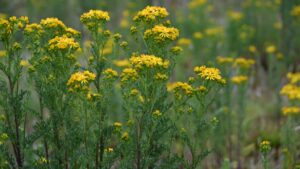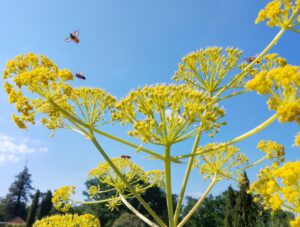
Podcast Episode 36 – The Dove From Above
PODCAST EPISODE 36: The Dove From Above Join us on a beautiful June evening for episode 36 of the Knepp Wildland Podcast. We’re joined by
Home / The year of the hawfinch?

Matt Phelps | Lead Ecologist
Seven years ago, in the autumn in 2017, hawfinches streamed across the North Sea towards us in great numbers. That winter saw a great influx of these impressive nutbrown birds to Knepp. And now it seems it is happening again.
This year, hawfinches have been recorded across the UK in awe-inspiring numbers. At Knepp, we’ve been seeing hawfinches almost weekly since the middle of October.
Just as we didn’t know for sure what caused 2017’s influx – although failing tree seed crops in Europe were suspected to be a factor – we don’t know why we’re seeing such sizeable flocks of hawfinches on our shores now.
At Knepp, we think these wandering individuals may be attracted to the abundance of sloes on our expansive scrubby wildlands. While these solid blackthorn berries are not a hawfinch’s normal choice of food, these birds are adaptable and their huge beaks can tackle just about anything, exerting as they do a pressure of 4kg per square centimetre. Hawfinches’ more usual winter food, such as beechmast, hornbeam seeds and yew berries are in short supply this year.
So, it seems our rewilded landscape may be providing important support for these opportunistic, resourceful birds.
And that’s obviously good news. The hawfinch, Coccothraustes coccothraustes, has been gradually ebbing away as a breeding species in recent decades, with perhaps fewer than a thousand pairs now breeding in the UK each year.
Over the past two decades, we’ve seen again and again at Knepp that species can bounce back remarkably quickly when they’re given the chance to do so. And sometimes it’s in the least likely of ways.
Take two of Knepp’s flagship species: the turtle dove and the nightingale. Both of these have suffered colossal declines in Britain in the past 50 years or so – 98% and 92%, respectively.
In the past, well-meaning conservationists have tended to lump turtle doves in with ‘farmland birds’ and nightingales in with ‘woodland birds’.
We now realise that this approach creates ecological silos instead of connected nature corridors. What we need is robust, landscape-scale populations, instead of fragmented and vulnerable groups of individuals, who are unable to interact with one another.
Pigeon-holing turtle doves and nightingales in this way can lead to restoration habitats of human-created hedgerows and field margins for turtle doves, and blocks of coppiced woodland for nightingales.
But that still assumes the solution can only be human-made.
But of course, species such as turtle dove and nightingale didn’t magically materialise out of thin air just around the time that humans began reshaping their habitats. These species evolved naturally – like so many – from complex and intermingling landscapes.
So, for me, one of the most exciting elements of rewilding is the chance it gives us to break outside of our own blinkered mindsets.
We must shrug off our limiting ideas about what landscapes should look like and what species need within them and learn directly from the land and species themselves.
Image credit: Ed Stubbs

PODCAST EPISODE 36: The Dove From Above Join us on a beautiful June evening for episode 36 of the Knepp Wildland Podcast. We’re joined by

Matt Phelps | Lead Ecologist It’s mid-June and the countryside is quietly gearing up for its summer crescendo. You might have noticed it already— what

Moy Fierheller | Deputy Head Gardener Visit Knepp’s rewilded Walled Garden The fine, fairy-tale spring continues and the Met Office reports it’s the sunniest in
Knepp Wildland Safaris, our gardens and campsite are all about the quiet and patient observation of nature.
Some of the species we are likely to encounter are shy or can be frightened by loud noises or sudden movements. Our campsite with open-air fire-pits, wood-burning stoves and an on-site pond is unsuitable for small children.
For this reason, our safaris, garden visits, holiday cottages and campsite are suitable only for children of 12 and over.